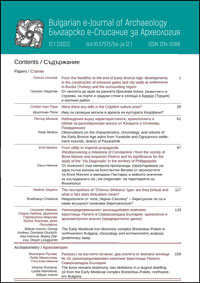From utility to imperial propaganda: (Re)discovering a milestone of Constantine I from the vicinity of Bona Mansio and emporion Pistiros and its significance for the study of the ‘Via Diagonalis’ in the territory of Philippopolis
From utility to imperial propaganda: (Re)discovering a milestone of Constantine I from the vicinity of Bona Mansio and emporion Pistiros and its significance for the study of the ‘Via Diagonalis’ in the territory of Philippopolis
Author(s): Emil NankovSubject(s): History, Archaeology
Published by: Асоциация на българските археолози
Keywords: imperial roads; Via Diagonalis; road stations; milestones; province of Thracia; Philippopolis;
Summary/Abstract: This article republishes a fragmentary milestone dedicated to Constantine I and his sons discovered by chance in 1964 in the locality “Kaldarmata” situated ca. 4 km south of the village of Vinogradets, Pazardzhik district. It also attempts to place it within its micro–regional context, as part of the larger network of Roman settlements serving the interregional traffic along the ‘Via Diagonalis’ in the Western Upper Thrace valley. For road stations operated not in isolation, but as a constituent part of larger organisms utilizing a wide range of resources on a micro–regional level. A new look at the milestone’s findspot, date, historical context and relation to other milestones found in the region is necessary because its place of discovery puts the actual route of the ‘Via Diagonalis’ in close proximity to the fortified settlement at Gradishteto near Asardere, situated ca. 2 km west of “Kaldarmata” and ca. 5 km east of the town of Vetren, commonly identified with Bona Mansio, which was the last road station in the territory of Philippopolis during Late Antiquity. The diachronic analysis of other milestones found in the region allows us to capture the milestone’s evolving function as a medium of communication between the imperial administration and its subjects within the 3rd and the 4th centuries AD; from a road accessory providing practical information to travellers into an administrative tool displaying imperial propaganda. Evidently, all the examples discussed in this article illustrate the existence of a milestone cluster associated with mansio Lissae/Bona Mansio, thereby showcasing the significance of the Western Upper Thrace Valley as an important hub along the ‘Via Diagonalis’.
Journal: Българско е-Списание за Археология
- Issue Year: 12/2022
- Issue No: 1
- Page Range: 97-116
- Page Count: 19
- Language: English

